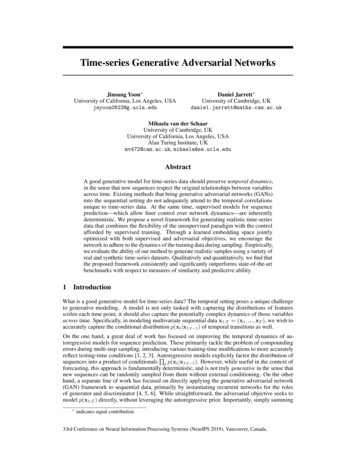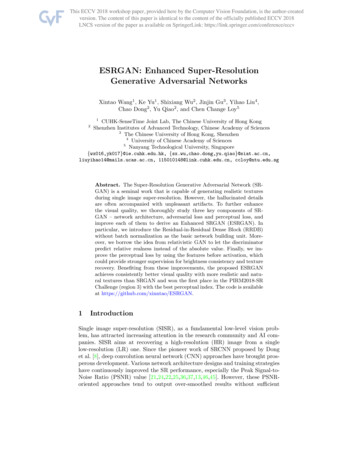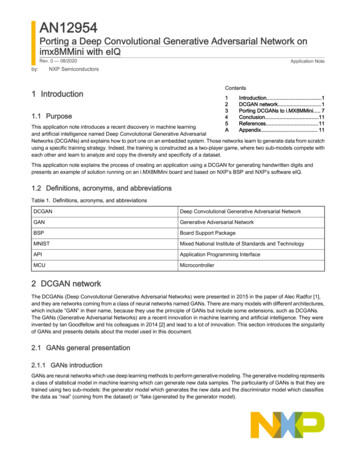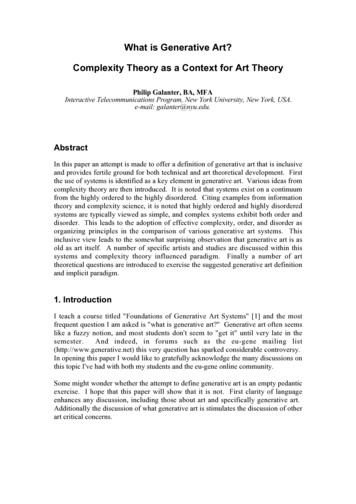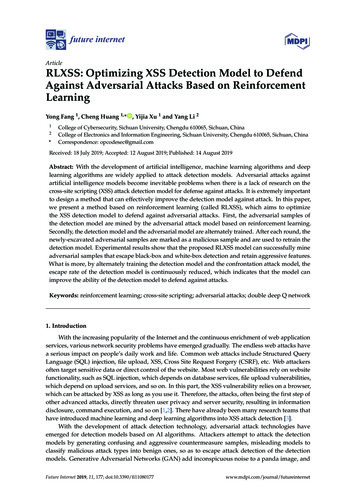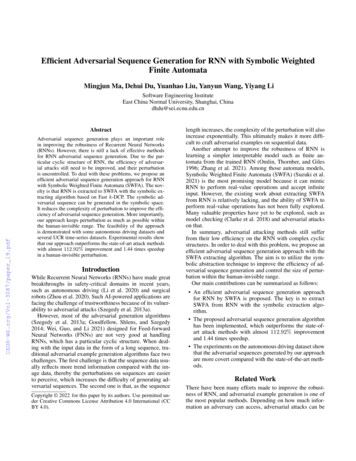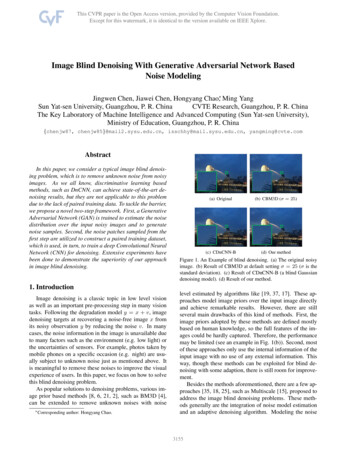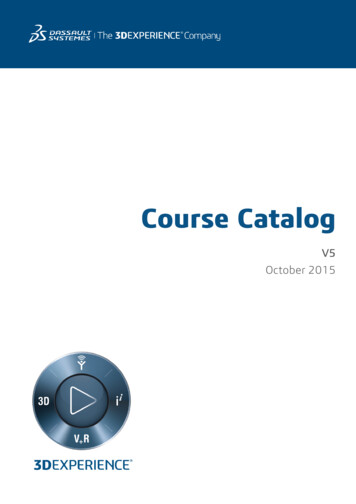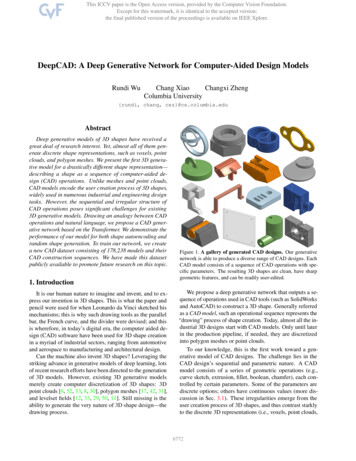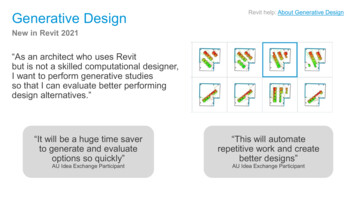
Transcription
Sylvain CombettesMaster of Science candidateEcole des Mines de NancyDepartment of Applied MathematicsQ sylvain.combettes [a t] mines-nancy.org https://www.linkedin.com/in/sylvain-combettes https://github.com/sylvaincomInternship report Generative Adversarial Networks(GANs)June 24th – September 13th, 2019Topic:Generating fictitious realistic patient data using GANs (generativeadversarial networks)Internship supervisors:Fabrice C OUVELARDRomain G UILLIERCompany:Servier50 Rue Carnot, 92284 SuresnesDepartment:Pôle d’Expertise Méthodologie et Valorisation des Données (PEXMVD)AbstractIn the first chapter, we do a general presentation on GANs, in particular how they work.GANs are a revolutionary generative model invented by Ian G OODFELLOW in 2014. Thekey idea behind GANs is to have two neural networks competing against each other: thegenerator and the discriminator. GANs can synthesize samples that are impressivelyrealistic.In the second chapter, we apply GANs to patient data. The method is called medGAN (formedical GAN) and was developed by Edward C HOI in 2018. medGAN can only synthesizebinary or count values. There are two main applications of medGAN: privacy and datasetaugmentation. We only focus on dataset augmentation from a real-life dataset: wegenerate fictitious yet realistic samples that can then be concatenated with the real-lifedataset into an augmented dataset (that has more samples). Training a predictive modelon the augmented dataset rather than the real-life dataset can boost the predictionscore (if the generated data is realistic enough). All the programs can be found on myGitHub.
2
ContentsAcknowledgments5Introduction7IGeneral presentation on generative adversarial networks (GANs)11I.1Some preliminary notions . . . . . . . . . . . . . . . . . . . . . . . . . . . . . . . . . . .13I.1.1Supervised vs. unsupervised learning . . . . . . . . . . . . . . . . . . . . . . . .13I.1.2What is a generative model? . . . . . . . . . . . . . . . . . . . . . . . . . . . . . .13I.1.3Why are generative models interesting? . . . . . . . . . . . . . . . . . . . . . . .15I.1.4A few important concepts and facts of machine learning . . . . . . . . . . . . .16How do GANs work? . . . . . . . . . . . . . . . . . . . . . . . . . . . . . . . . . . . . . .21I.2.1The principle: generator vs discriminator . . . . . . . . . . . . . . . . . . . . . .21I.2.2The two-player minimax game . . . . . . . . . . . . . . . . . . . . . . . . . . . .23I.2.3Gradient descent . . . . . . . . . . . . . . . . . . . . . . . . . . . . . . . . . . . .23I.2.4Application: some simulations with TensorFlow and GAN Lab . . . . . . . . .26Comparison of GANs with other generative models . . . . . . . . . . . . . . . . . . . .26I.2I.3II Application of GANs to electronic health records (EHR)27II.1 Theoretical approach: medGAN . . . . . . . . . . . . . . . . . . . . . . . . . . . . . . . .29II.1.1 How can Servier benefit from GANs? . . . . . . . . . . . . . . . . . . . . . . . .29II.1.2 What are autoencoders? . . . . . . . . . . . . . . . . . . . . . . . . . . . . . . . .30II.1.3 How does medGAN work? . . . . . . . . . . . . . . . . . . . . . . . . . . . . . . . .33II.2 Algorithmic implementation . . . . . . . . . . . . . . . . . . . . . . . . . . . . . . . . .36II.2.1 The medGAN program from Edward C HOI’s GitHub . . . . . . . . . . . . . . . .36II.2.2 Explanation of the code’s steps . . . . . . . . . . . . . . . . . . . . . . . . . . . .37II.3 Experimental results . . . . . . . . . . . . . . . . . . . . . . . . . . . . . . . . . . . . . .39II.3.1 For the MIMIC-III dataset of shape (46 520, 1 071) with binary values . . . . .393
II.3.2 For the MIMIC-III dataset of shape (1 000, 100) with binary values . . . . . . .41II.3.3 For the MIMIC-III dataset of shape (46 520, 1 071) with count values . . . . .47II.3.4 For the MIMIC-III dataset of shape (1 000, 100) with count values . . . . . . .49Conclusion53Bibliography54Notation57List of Figures58List of Tables604
AcknowledgmentsI would like to thank Fabrice C OUVELARD and Romain G UILLIER, my internship supervisors, for thisgreat experience. I was able to learn a lot from them. I thank them for letting me conduct researchin a autonomous way, for their advice and for creating a pleasant work atmosphere.I would also like to thank the rest of the data science team: Antoine H AMON, Florent L EFORT, SylvainP UYRAVAUD, Freddy L ORIEAU and Cheima B OUDJENIBA. I was able to ask them questions aboutprogramming or data science and they have been very helpful.Finally, I thank everybody at Servier for their professionalism and sympathy.5
6
IntroductionOver the past decade, the explosion of the amount of data available – Big Data – the optimization ofalgorithms and the constant evolution of computing power have enabled artificial intelligence (AI)to perform more and more human tasks. In 2018, Google’s CEO Sundar P ICHAI predicted that AIwill have a deeper impact than electricity or fire. In 2018, the McKinsey Global Institute predictedthat AI will create an economic value of 2.7 trillion over the next 20 years.AI aims at simulating human intelligence. Nowadays, AI is able to compute faster than humans andbeat them at the game of Go. In his TED Talk [22], Martin F ORD explains that the fact that GoogleDeepMind’s artificial intelligence program AlphaGo was able to beat the best player at the game ofGo in May 2017 is a breakthrough. Indeed, the game of Go has an infinite number of possibilities sono computer can analyze each possibility, but also because even the best players say that the gameof Go is very intuitive.How can we define artificial intelligence? In 1950, Alan T URING proposed an intelligence testfor machines. According to [13], the game of imitation consists in developing a machine that isindistinguishable from a human being. Specifically, T URING suggested that a judge J exchangetyped messages with a human being H on the one hand and a machine M on the other hand. Thesemessages could cover all kinds of topics. The judge J does not know which of his two interlocutors(whom he knows as A and B ) is the machine M and which is the human H . After a series ofexchanges, the judge J must guess who is the machine and who is the human being. T URINGthought that if one day we succeed in developing machines that make it impossible to identifycorrectly (i.e. lead the judge J to a 50% misidentification rate identical to what a random answerwould give), then we can claim to have designed an intelligent machine or – what we will considerequivalent – a machine that thinks.The introduction of the Deep Learning book [3] states the following:« In the early days of artificial intelligence, the field rapidly tackled and solved problemsthat are intellectually difficult for human beings but relatively straightforward for computers – problems that can be described by a list of formal, mathematical rules. The truechallenge to artificial intelligence proved to be solving the tasks that are easy for peopleto perform but hard for people to describe formally – problems that we solve intuitively,that feel automatic, like recognizing spoken words or faces in images. »If we claim that the purpose of AI is to simulate human intelligence, the main difficulty is creativity.In the field of AI, we talk about generative models and one of the most popular model nowadays isGANs (for "generative adversarial networks").Before discussing the technical part of the topic (i.e. scientific papers), it is very informative toread popular science articles, for example from Sciences and Future [17], Les Echos [18] [19] [20]or MIT Technology Review [14] [15]. They allow us to have a global and synthetic vision of GANs7
in order to better understand the technical details. According to [14], « Yann LeCun, Facebook’schief AI scientist, has called GANs “the coolest idea in deep learning in the last 20 years.” Another AIluminary, Andrew Ng, the former chief scientist of China’s Baidu, says GANs represent “a significantand fundamental advance” that’s inspired a growing global community of researchers. »In 2014, Ian G OODFELLOW invented GANs [1] and was then nicknamed "the GANfather". In his firstpaper that introduced GANs [1], G OODFELLOW included the bar where he first got the idea of GANsin the acknowledgments part: « Finally, we would like to thank Les Trois Brasseurs for stimulatingour creativity. ». In 2019, aged 34, he was nominated in Fortune’s 40 under 40 – an annual selectionof the most influential young people – with the following description:« As one of the youngest and most respected A.I. researchers in the world, Ian Goodfellowhas kept busy pushing the frontiers of deep learning. Having studied under some of theleading deep-learning practitioners like Yoshua Bengio and Andrew Ng, Goodfellow’sexpertise involves neural networks, the A.I. software responsible for breakthroughs incomputers learning how to recognize objects in photos and understanding language.Goodfellow’s creation of so-called generative adversarial networks (GANs) has enabledresearchers to create realistic-looking but entirely computer-generated photos of people’sfaces. Although his techniques have allowed the creation of controversial “deepfake”videos a , they’ve also paved the way for advanced A.I. that can create more realistic sounding audio voices, among other tasks. Apple recently took notice of Goodfellow’s workand hired him to be the iPhone maker’s director of machine learning in the company’sspecial projects group. He was previously a star senior staff research scientist at Googleand researcher at the high-profile nonprofit OpenAI. »Source: waAccording to Wikipedia, « Deepfake (a portmanteau of "deep learning" and "fake") is a technique forhuman image synthesis based on artificial intelligence. It is used to combine and superimpose existingimages and videos onto source images or videos using a machine learning technique known as generativeadversarial network. The phrase "deepfake" was coined in 2017. Because of these capabilities, deepfakeshave been used to create fake celebrity pornographic videos or revenge porn. Deepfakes can also be usedto create fake news and malicious hoaxes. » One main example of deepfake is https://www.youtube.com/watch?v cQ54GDm1eL0: a fake video of Obama warns us against fake news [21].According to [14], « The magic of GANs lies in the rivalry between the two neural nets. It mimicsthe back-and-forth between a picture forger and an art detective who repeatedly try to outwit oneanother. Both networks are trained on the same data set. The first one, known as the generator,is charged with producing artificial outputs, such as photos or handwriting, that are as realisticas possible. The second, known as the discriminator, compares these with genuine images fromthe original data set and tries to determine which are real and which are fake. On the basis ofthose results, the generator adjusts its parameters for creating new images. And so it goes, until thediscriminator can no longer tell what’s genuine and what’s bogus. » GANs can be used to imitateany data distribution (image, text, sound, etc.).An artwork created thanks to them, based on the analysis of 15,000 examples, was recently putup for auction for a total amount of 432,500. This artwork is displayed on figure 1. It is signedat the bottom right with minθg maxθd Ex p data log D θd (x) Ez p(z) log(1 D θd (G θg (z))), which is thefundamental equation I.3 of subsection I.2.2 on which the GAN algorithm 1 is based. Printed oncanvas, the work belongs to a series of generative images called « La Famille de Belamy », where thename « Belamy » is the French translation of « Goodfellow ».The main application of GANs (and deep learning in general) concerns computer vision as well as8
Figure 1: Portrait generated in 2018 by Paris-based arts-collective Obvious with GANs sold with anauction price of 432 000 Source: l language processing (NLP). Note that in computer vision, images are represented as a 2-Dgrid of pixels, as shown in figure 2. When a computer looks at this image, it does not get the conceptof cat as a human would. Instead, the computer is representing the image as a (gigantic) grid ofnumbers. If the size of the image is 800 600 and each pixel is represented by 3 numbers between[0, 255] (giving the red, green, and blue value for that pixel), then we have an array of 800 600 3numbers. This array of 800 600 3 numbers can be stretched out into a vector of dimension1 440 000 800 600 3. In short, an image is seen as a high-dimensional vector through its pixels.7KH 3UREOHP 6HPDQWLF *DS:KDW WKH FRPSXWHU VHHV Q LPDJH LV MXVW D ELJ JULG RI QXPEHUV EHWZHHQ @H J [ [ FKDQQHOV 5*%7KLV LPDJH E\ 1LNLWD LV OLFHQVHG XQGHU && % Figure 2: The semantic gap between the concept of cat (that a human sees) and the pixel values(that thecomputer -XVWLQ -RKQVRQ sees))HL )HL /L 6HUHQD HXQJ/HFWXUH SULO Source: Standord CS231n [2] lecture 2In this report, we try to extend the range of GANs to electronic health records (EHR), more preciselyto patient data.9
10
Chapter IGeneral presentation on generativeadversarial networks (GANs)In AI, generative adversarial networks (GANs) are a generative model. GANs are an unsupervisedlearning method using two neural networks.Just for information, here are some interesting websites that include references in order to understand GANs from A to Z: Jason B ROWNLEE. Best Resources for Getting Started With Generative Adversarial Networks(GANs). 2019. / Ajay Uppili A RASANIPALAI. Generative Adversarial Networks - The Story So 19. A Beginner’s Guide to Generative Adversarial Networks (GANs). work-ganThe resources I highly recommend are Ian G OODFELLOW’s tutorial [4] and Stanford CS231n lecture13 "Generative models" [2]. G OODFELLOW’s article [4] comes with the video on the conferencehe gave and is available at https://www.youtube.com/watch?v HGYYEUSm-0Q. Stanford’s lecture [2]was recorded and is available at https://www.youtube.com/watch?v 5WoItGTWV54&list PLC1qULWwrF64f4QKQT-Vg5Wr4qEE1Zxk&index 14&t 0s. For any concepts of Deep Learning, G OODFEL LOW ’s book [3] is a reference and is available at https://www.deeplearningbook.org/.For information, the Deep Learning textbook [3] (by G OODFELLOW et al) dedicates 4 pages (690-693)on GANs (subsection 20.10.4).This chapter is a general presentation on GANs. In this chapter, we do not try to apply GANs to thepharmaceutical world. We will explain some preliminary notions, go into the details of how GANswork (up to its fundamental equation (I.3)) and explain why we chose GANs over other existingmethods. Finally, as GANs’ main application is computer vision, we will apply GANs to medicalimaging and take part in one of Servier Data Science team’s project about IRM (nuclear magneticresonance) of knees.We will apply GANs to electronic health records (EHR) only in chapter II.11
ContentsI.1 Some preliminary notions . . . . . . . . . . . . . . . . . . . . . . . . . . . . . . . . . . 13I.1.1Supervised vs. unsupervised learning . . . . . . . . . . . . . . . . . . . . . . . . 13I.1.2What is a generative model? . . . . . . . . . . . . . . . . . . . . . . . . . . . . . . 13I.1.3Why are generative models interesting? . . . . . . . . . . . . . . . . . . . . . . . 15I.1.4A few important concepts and facts of machine learning . . . . . . . . . . . . . 16I.1.4.aAbout the training dataset . . . . . . . . . . . . . . . . . . . . . . . . . 16I.1.4.bAbout deep learning . . . . . . . . . . . . . . . . . . . . . . . . . . . . . 18I.1.4.cMaximum Likelihood Estimation . . . . . . . . . . . . . . . . . . . . . 19I.1.4.dKullback-Leibler (KL) divergence . . . . . . . . . . . . . . . . . . . . . 19I.2 How do GANs work? . . . . . . . . . . . . . . . . . . . . . . . . . . . . . . . . . . . . . 21I.2.1The principle: generator vs discriminator . . . . . . . . . . . . . . . . . . . . . . 21I.2.2The two-player minimax game . . . . . . . . . . . . . . . . . . . . . . . . . . . . 23I.2.3Gradient descent . . . . . . . . . . . . . . . . . . . . . . . . . . . . . . . . . . . . 23I.2.4Application: some simulations with TensorFlow and GAN Lab . . . . . . . . . 26I.3 Comparison of GANs with other generative models . . . . . . . . . . . . . . . . . . . 2612
I.1 Some preliminary notionsI.1.1 Supervised vs. unsupervised learningThis subsection is taken from Stanford’s lecture [2].In supervised learning, we have labeled training data: we have some data x and some labels y. Thegoal is to learn a function that is mapping from the data x to the labels y. These labels can takedifferent types of forms, for example categories of animals or captions of images. Regression is anexample of supervised learning.In the unsupervised learning setting, we have unlabeled training data: we only have some datax with no labels y. The goal is to learn some underlying hidden structure of the data x (for example grouping, axes of variation, underlying density estimation.). Clustering is an example ofunsupervised learning.Compared to supervised learning, unsupervised learning is less expensive because we do not needto train on labels. By comparison to supervised learning, unsupervised learning is still an unsolvedresearch area. On the other hand, the potential of unsupervised learning is more interesting becauseit detects itself inherent structures in the data x. According to [14],« Today, AI programmers often need to tell a machine exactly what’s in the training datait’s being fed – which of a million pictures contain a pedestrian crossing a road, and whichdon’t. This is not only costly and labor-intensive; it limits how well the system deals witheven slight departures from what it was trained on. In the future, computers will get muchbetter at feasting on raw data and working out what they need to learn from it withoutbeing told.That will mark a big leap forward in what’s known in AI as “unsupervised learning.” Aself-driving car could teach itself about many different road conditions without leavingthe garage. A robot could anticipate the obstacles it might encounter in a busy warehousewithout needing to be taken around it. »I.1.2 What is a generative model?This subsection is taken from Stanford’s lecture [2] and G OODFELLOW’s tutorial [4].Generative models are a type of unsupervised learning. The goal of a generative model is, giventraining data, to generate new samples from the same distribution (as the training data). We wantto learn a model p model (x) which is similar to p data (x), with p data (x) being unknown. Generativemodels address density estimations, a core problem in unsupervised learning.There are two types of generative models: explicit density estimation: explicitly define and solve for p model (x), implicit density estimation: learn a model that can sample from p model (x) without explicitlydefining p model (x).An example of explicit density estimation is given figure I.1: Gaussian model for a one-dimensionallearning database. A generative model with explicit density estimation is based on a set of examplesdrawn from an unknown data-generating distribution p data (x) and outputs an estimation p model (x)13
of this distribution. The estimated model p model (x) can be evaluated for a particular value x 0 inorder to obtain an estimate p model (x 0 ) of the true density p data (x 0 ). We can sample new data fromp model (x).Figure I.1: An example of explicit density estimationSource: G OODFELLOW’s tutorial [4]An example of implicit density estimation is given figure I.2. Of course, for the training data, wehave a lot more images than the three that are shown. Once we have learned p model (x), we cangenerate as many samples as we want.training data from p data (x)generated samples from p model (x)Figure I.2: An example of implicit density estimationSource: Stanford CS231n [2]GANs are an implicit density estimation problem. I will provide more details in section I.2.A taxonomy of generative models is shown in figure I.3. The most popular are PixelRNN/CNN,Variational Autoencoder (VAE) and GANs. According to Wikipedia, in the computational complexitytheory, « tractable » means « a problem that can be handled ». In particular, we can not optimizedirectly an intractable density function. For intractable problems, we can only have the approximatedensity (and not the exact one as with tractable problems).Figure I.3: A taxonomy of generative modelsSource: Stanford CS231n [2]14
I.1.3 Why are generative models interesting?Generative models have several very useful applications: colorization, super-resolution, generationof artworks, etc. In general, the advantage of using a simulated model over the real model is thatthe computation can be faster.Many interesting examples are given in G OODFELLOW’s tutorial [4] and Stanford’s lecture [2]. Inparticular, examples given by G OODFELLOW in the conference « Generative Adversarial Networks(NIPS 2016 tutorial) », from 4:15 to 12:33, are impressive and I highly recommend watching them.The link to this video, on which the paper [4] is based, is the following: https://www.youtube.com/watch?v HGYYEUSm-0Q.We are now going to give three examples where the generative aspect is very useful. These examplesare taken from G OODFELLOW’s tutorial [4].A first example of GANs’ results is given figure I.4. The generation of these fictional celebrityportraits, from the database of real portraits C ELEBA -HQ composed of 30 000 images, took 19 days.The generated images have a size of 1024 1024 but have been compressed in this report. Theseportraits are very realistic.Figure I.4: Realistic fictional portraits of celebrities generated from originals using GANsSource: Nvidia [10]An article from the MIT Technology Review [14] states about figure I.4:« In one widely publicized example last year, researchers at Nvidia, a chip company heavily invested in AI, trained a GAN to generate pictures of imaginarycelebrities by studying real ones. Not all the fake stars it produced were perfect,but some were impressively realistic. »A second example is given figure I.5. These real images are transposed into realistic fictional images- or vice versa - with the CycleGan developed by researchers at the University of Berkeley. Theconcept, called image-to-image translation, is a class of vision and graphics problems wherethe goal is to learn the mapping between an input image and an output image using a training15
Figure I.5: CycleGAN: real images transposed into realistic fictional images using GANsSource: Berkeley AI Research (BAIR) laboratory [11]set of aligned image pairs. There exists a tutorial about CycleGAN on Tensorflow: ve/cyclegan.The third and last example is shown in figure I.6. For example, the aerial to map feature can be veryuseful to Google Maps or similar applications.Figure I.6: Several types of image transformations using GANsSource: Berkeley AI Research (BAIR) Laboratory [12]We can note that most GANs’ applications are computer vision (or at least image retlated). We willsee in chapter II that it is possible, to a certain extent, to apply GANs to electronic health records(EHR).I.1.4 A few important concepts and facts of machine learningI.1.4.a About the training datasetä Let us not be confused by the term "generative model": AI is not creative, it can only learnfrom the training database. Thus, in addition to code quality, a quality training database16
is required to obtain consistent output results: unbiased, with a lot of samples and goodfeatures.ä When our learning dataset is small (not enough samples), it is difficult to build a relevantmodel. For example, we may have the problem of overfitting.The Deep Learning textbook [3] pages 18-20 on the importance a large training dataset:« It is true that some skill is required to get good performance from a deep learning algorithm.Fortunately, the amount of skill required reduces as the amount of training data increases.The learning algorithms reaching human performance on complex tasks today are nearlyidentical to the learning algorithms that struggled to solve toy problems in the 1980s, thoughthe models we train with these algorithms have undergone changes that simplify the trainingof very deep architectures. The most important new development is that today we can providethese algorithms with the resources they need to succeed. [.] The age of “Big Data” has mademachine learning much easier because the key burden of statistical estimation – generalizingwell to new data after observing only a small amount of data – has been considerably lightened.As of 2016, a rough rule of thumb is that a supervised deep learning algorithm will generallyachieve acceptable performance with around 5,000 labeled examples per category and willmatch or exceed human performance when trained with a dataset containing at least 10million labeled examples. »It is important to keep these orders of magnitude in mind. However, an article from the MITTechnology Review [14] explains that:« Unlike other machine-learning approaches that require tens of thousands of training images,GANs can become proficient with a few hundred. ».ä The Deep Learning textbook [3] page 3 on the importance of choosing good features for ourtraining dataset:« The performance of these simple machine learning algorithms depends heavily on therepresentation of the data they are given. [.] [For example,] people can easily performarithmetic on Arabic numerals but find arithmetic on Roman numerals much more timeconsuming. [.] Many artificial intelligence tasks can be solved by designing the right set offeatures to extract for that task, then providing these features to a simple machine learningalgorithm. For example, a useful feature for speaker identification from sound is an estimateof the size of the speaker’s vocal tract. This feature gives a strong clue as to whether thespeaker is a man, woman, or child. For many tasks, however, it is difficult to know whatfeatures should be extracted. »ä We do not really care about the performance of a classifier on training data: we use trainingdata to find some classifier and then we apply this classifier on test data (thus we try to avoidoverfitting).Our model should be "simple" to make our model work on test data: we can use regularization in the loss function to encourage our model to be "simple". The concept of "simple"depends on the task and the model. If we have many different competing hypothesis onsome observations, we should prefer the simpler one because it is the one that is more likelyto generalize to new observations in the future. For example, if we have to choose betweenseveral polynomial models that fit our training data, we prefer the model with the lowestdegree.17
I.1.4.b About deep learningä When a distribution is complicated, it is more appropriate to try to estimate it using neuralnetworks [2]. In particular, deep networks have the ability to learn complex patterns fromdata because it enables the computer to build complex concepts out of simpler concepts [3].As we will see later, GANs use two neural networks.ä The Deep Learning textbook [3] pages 14 and 16 on the influence of neuroscience on deeplearning:« Today, neuroscience is regarded as an important source of inspiration for deep learningresearchers, but it is no longer the predominant guide for the field. The main reason for thediminished role of neuroscience in deep learning research today is that we simply do not haveenough information about the brain to use it as a guide. [.] one should not view deep learningas an attempt to simulate the brain. Modern deep learning draws inspiration from manyfields, especially applied math fundamentals like linear algebra, probability, informationtheory, and numerical optimization. »ä For computer vision, deep learning is mostly used nowadays.ä According to the Deep Learning textbook [3] page 12, « deep learning dates back to the 1940s.Deep learning only appears to be new, because it was relatively unpopular for several yearspreceding its current popularity, and because it has gone through many different names, onlyrecently being called “deep learning.” »ä In 2018, Yoshua B ENGIO, Geoffrey H INTON and Yann L E C UN won the Turing Award – the"Nobel Prize of computing" – for conceptual and engineering breakthroughs that have madedeep neural networks a critical component of computing. B ENGIO was one of G OODFELLOW’sdoctoral advisor and is the co-author of the Deep Learning textbook [3].ä The Deep Learning textbook [3] page 12 on how deep learning became so popular:« we identify a few key trends: Deep learning has had a long and rich history, but has gone by many names, reflectingdifferent philosophical viewpoints, and has waxed and waned in popularity. Deep learning has become more useful as the amount of available training data hasincreased. Deep learning models have grown in size over time as computer infrastructure (bothhardware and software) for deep learning has improved. Deep learning has solved increasingly complicated applications with increasing accuracyover time. »ä According to [3] page 14, slightly modified versions of the stochastic gradient descent (SGD)algorithm are the dominant training algorithms for deep learning models today. Let us notethat the step size (also called learning rate) is a hyperparameter.According to Stanford CS231n lecture 3 (available at https://www.youtube.com/watch?v h7iBpEHGVNc&list PLC1qU-LWwrF64f4QKQT-Vg5Wr4qEE1Zxk&index 3), the most pop
Contents Acknowledgments 5 Introduction 7 I General presentation on generative adversarial networks (GANs) 11 I.1 Some preliminary notions .
